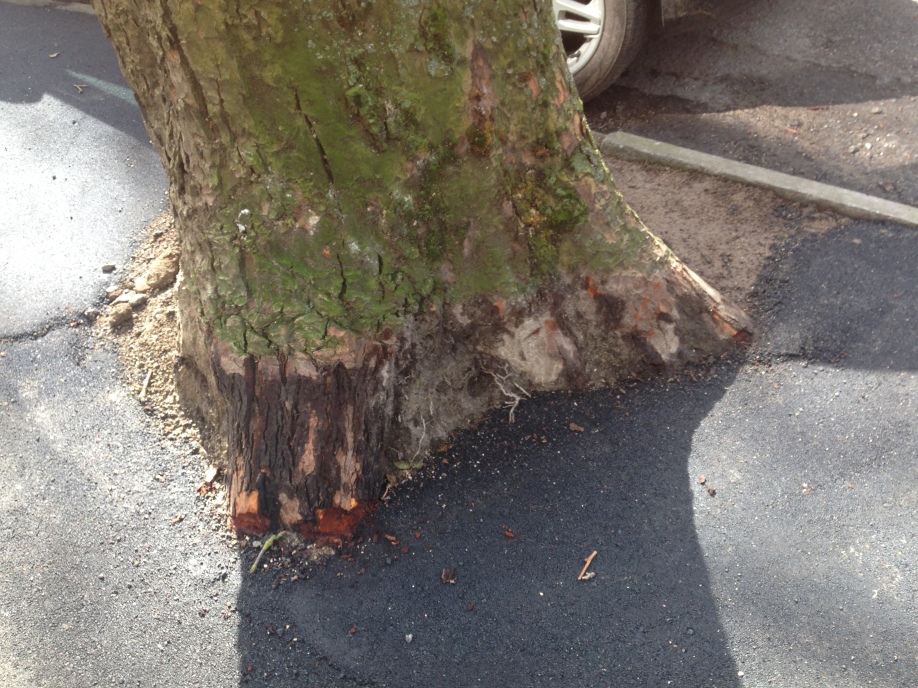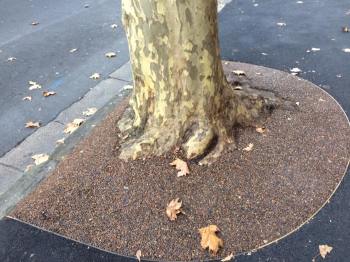What are Engineering Solutions?
You may be wondering why anyone would want to read a page about Engineering Solutions. This issue is, however, at the core of STAG’s campaign for greater transparency from Sheffield City Council. The Council frequently repeat that healthy trees are only removed as a “last resort”. To anyone knowing little about retaining healthy highway trees – and this is most people – this statement sounds reasonable enough. Unfortunately the facts do not support the Council’s claim.
There are many simple, cheap (or even completely free) measures that can be taken to retain healthy highway trees condemned for causing damage to kerbs and/or pavements. These measures – commonly called Engineering Solutions – are used as standard by Local Authorities all over the UK but there is little evidence for their use here in Sheffield.
The £2.1 billion-pound PFI contract, signed by Sheffield City Council, The Department of Transport and Amey Plc. in 2012 provides money for 14 Engineering Solutions. Under the terms of the contract using these options would present no extra costs to the people of Sheffield, although there has been much confusion over this particular point.
Clarification was provided by Steve Robinson, Head of Highways at SCC. When speaking at the ‘Highway Tree Advisory Forum’ on 2nd September 2015 he said:
“The engineering and tree-based solutions come at no extra cost to the Council. The taxpayer does not pay if an engineering solution or a tree-based solution can be applied.”
The 14 ‘Engineering and Tree-Based Solutions’
The Streets Ahead: Five Year Tree Management Strategy lists the options included within the terms of the PFI contract:
Engineering Solutions
1. Installation of thinner profile kerbs.
2. Excavation of footways for physical root examination prior to an ultimate decision being made on removal.
3. Ramping / Re-profiling of footway levels over roots (within acceptable deviation levels).
4. Flexible paving/surfacing solution.
5. Removal of displaced kerbs leaving a gap in the channel.
6. Filling in of pavement cracks.
Alternative Solutions (also known as ‘Tree-Based Solutions’)
7. Root pruning.
8. Root shaving.
9. Root barriers and root guidance panels.
10. Excavation beneath the roots damaging the footway.
11. Tree growth retardant.
12. Creation of larger tree pits around existing trees.
13. Heavy tree crown reduction/pollarding to stunt tree growth.
14. Retain dead, dying, dangerous and diseased trees for their habitat value.
Where are Amey’s examples of these solutions?
STAG has a citywide membership and, aside from a few tree pits (Solution 12), so far we have found only a handful of locations where the listed solutions have been used . We recognise that not all of the above solutions are obvious, as with the root inspections that were ordered for some lime-trees on Rustling Road and for eight of Western Road’s War Memorial Trees (Solution 2).
The most visible solutions would be numbers 1,3,4 and 5 and yet, apart from a few thinner profile kerbs and the odd example where a kerb has been removed, these are noticeable by their absence. This is strange considering that Solutions 1,3 & 5 would cost next to nothing to implement.
Even when the ‘Household Survey’ results show that residents want to keep their trees, and the ‘Independent Tree Panel’ agrees to retain them, Engineering and Tree Based Solutions are still not actioned, and healthy trees are felled unnecessarily. It is hard to understand why SCC thinks them inappropriate considering the circumstances. Why are we being denied these standard remedies when they cost nothing extra to deploy?
A concerned resident began a lengthy email exchange with members of the Streets Ahead team, asking them to provide specific instances of where the solutions have been used. Official replies were vague and somewhat conflicting:
- “Unfortunately we do not keep a formal record of why or how trees have been retained.”
- “Evidence of engineering solutions being used across the city will be visible on all roads where we have successfully carried out the highway upgrade works around the existing highway trees.”
- “In the vast majority of cases, tree retention can be achieved by very subtle or non-visible measures.”
The few examples offered by Amey to STAG, which we were unable to locate, were “based on officer recollections rather than formal inventory data.” You would think that SCC and Amey would be only too happy to showcase their efforts to retain Sheffield’s trees using any of the listed solutions.
At the High Court in February 2016 SCC’s solicitor told Justice Gilbart that ‘damaging’ trees would only be removed if the damage caused was:
“…such that it cannot be rectified by using reasonably practicable engineering solutions such as flexible paving materials, root removal, raising the footpath level or the use of thinner and/or smaller kerbs.”
STAG are still waiting for clear evidence of this policy being put into widespread practice.
Engineering Solutions spotted in other locations (not in Sheffield)
installing a thinner profile kerb will ensure that where the road edge meets the pavement it remains straight.
Flexi™–Pave, made of recycled rubber, stone and a bonding-agent, adjusts as roots grow or shrink and prevents cracking. It also allows water through to tree roots and well-watered trees are less likely to put out exploratory roots that create pavement disruption. In appearance it resembles smooth gravel.
the complete removal of displaced kerbs is the easiest, and cheapest, option.
a tree pit is best installed when a tree is first planted, although it can be retro-fitted around existing tree roots to safeguard against future problems.
How Engineering Solutions could be used in Sheffield
A case study: Western Road War Memorial Trees
Western Road’s trees have been neglected for over 20 years and during this time the pavement has been patched-up with many layers of tarmac. This has caused the trees to grow larger roots in search of moisture, creating humps and cracking on some sections of pavement, and the kerb is displaced. Solution 12: larger tree-pits, or Solution 4: flexible paving/surfacing solution (Flexi™–Pave) would have prevented this, and it is still not too late to use these strategies to prevent problems down the line.
23 trees are listed for felling, out of which 22 are healthy and one has fungal disease. SCC ordered that 8 out of the trees should undergo a root inspection, a rare instance of where Solution 2: excavation of footways for physical root examination prior to an ultimate decision being made on removal has been actioned.
During the examination several layers of tarmac were removed and when complete one layer of tarmac was put down so that the pavement would be usable. The results are revealing:

If you look closely at the tree trunk you will see a tide-mark showing the level of the pavement around the tree before the surrounding tarmac was taken away. Once several layers of tarmac had been removed and a single layer of tarmac had been laid, the pavement was acceptably flat.
The pavement renewal process requires the uppermost tarmac layers to be scraped, sometimes superficially, sometimes to a deeper level. There is no real reason for the thick deposits around tree trunks to not be dealt with at the same time. The planing-machine used on sections of pavement between the trees would not be used over roots that have broken the surface. Extra care would need to be taken around some of the threatened trees to avoid damaging roots. A skilled highways operative could provide this level of expertise and STAG believe, after talking with workers on the ground, that they would be only too happy to use their skills to retain these special trees.
In the case of Western Road, there are York Stone flags covering approximately half the street’s footways. These are scheduled to be lifted and relaid as part of pavement renewal, presenting an ideal opportunity to install tree pits or Flexi™–Pave around trees, and to re-profile the footway levels over the roots – Solutions 12, 4 and 3.
Ian Dalton, Tree Officer for the London Borough of Bromley, prepared a report that includes the 23 Western Road trees destined for removal. He concludes that apart from the one with fungus, all of them would be retained as a matter of course by the Local Authority that he works for. Ian said:
“simple excavation works using standard techniques and materials can easily rectify problems relating to damage to footways from tree roots. This is exactly the kind of work I and all other local authorities authorise on a daily basis in order to mitigate against the problem of trees damaging pavements with a view to retaining healthy street trees.”
These standard techniques include: Solution 3. Ramping / Re-profiling of footway levels over roots (within acceptable deviation levels) – this simple and cost-effective solution would go a long way to saving many of Western Road’s trees, where uneven pavements are given as the primary reason for felling. Where kerbs have been displaced, Solution 1: installation of thinner profile kerbs and Solution 5: removal of displaced kerbs leaving a gap in the channel could be used in most cases.
Road renewal should pose no threat to Western Road’s healthy highway trees
Amey say that trees with roots growing into the highway receive serious root-damage from ‘roadway renewal’, necessitating their removal.
However STAG has observed highway renewal operatives resurfacing Sheffield roads, using massive machinery with considerable delicacy and skill, so as to avoid damaging tree trunks and roots. Clearly skilled highway operatives can avoid this sort of damage.
In their letter to the Cabinet Member for Environment & Transport (Cllr Fox) in 2015 SORT refute Amey’s claim:
“Amey have scheduled many of these trees for felling on the basis that their planing machine and digging machinery will cause such severe damage to trees that they will become DANGEROUS (one of the 6Ds), as decay is expected to follow and it is thought structural integrity will be compromised.
As SORT indicate, compliance with current good practice guidance and recommendations, which the Streets Ahead team claim to comply with (such as National Joint Utilities Group Guidance and British Standard 5837: 2012), would ensure that such damage is avoided and would enable mature highway trees to be safely retained, long term, without unacceptable compromise to structural integrity.”
Peter Townsend, BSc C Eng MICE – a highway engineer with many years experience delivering Local Authority contracts like the ‘Streets Ahead’ programme prepared a report on Montgomery Road, Nether Edge, in which he states:
“…the main structural damage is to the kerbs with some rooting into the highway. The contractors have been able to resurface this road to a good standard despite these issues. The work on Montgomery Rd is normal practice and indicates that the highway renewal contractors are able to work round trees like this as a matter of routine.”
This ‘normal practice’ could help retain several of Western Road’s War-Memorial Trees.





